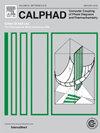后尖晶石型CaV2O4高温(298.15 ~ 1373 K)晶体结构与热力学性质
IF 1.9
3区 材料科学
Q4 CHEMISTRY, PHYSICAL
Calphad-computer Coupling of Phase Diagrams and Thermochemistry
Pub Date : 2025-06-21
DOI:10.1016/j.calphad.2025.102850
引用次数: 0
摘要
对高温固相煅烧合成的CaV2O4的晶体结构和热力学性质进行了分析。XRD分析表明,CaV2O4为正交晶型,晶型参数为a = 9.21311(10) Å, b = 3.008421(35) Å, c = 10.68206(12) Å, α = β = γ = 90°。在298.15 K下,CaV2O4的生成焓和熵分别为−1890.56±5.84 kJ/mol J·mol−1和129.62±1.09 J·mol−1 K−1。用滴量热法测定了573 ~ 1373 K时CaV2O4的热容,得到Cp = 165.7748 + 3.2353 × 10−2T - 2.64268 × 106T−2 (J·mol−1·K−1)。利用Cp,m表达式推导了CaV2O4在高温下的热力学数据。本文章由计算机程序翻译,如有差异,请以英文原文为准。

Crystal structure and thermodynamic properties of post-spinel-type CaV2O4 at high temperatures (298.15–1373 K)
We conducted an analysis of the crystal structure and thermodynamic properties of CaV2O4 synthesized through high-temperature solid-state calcination under elevated temperature conditions. The XRD analysis indicated that CaV2O4 crystallizes in an orthorhombic structure, characterized by unit cell parameters a = 9.21311(10) Å, b = 3.008421(35) Å, c = 10.68206(12) Å, and α = β = γ = 90°. The enthalpy of formation and entropy of CaV2O4 at 298.15 K are −1890.56 ± 5.84 kJ/mol J·mol−1 and 129.62 ± 1.09 J·mol−1 K−1, respectively. The heat capacity of CaV2O4 at 573–1373 K was determined using drop calorimetry, yielding the expression Cp = 165.7748 + 3.2353 × 10−2T - 2.64268 × 106T−2 (J·mol−1·K−1). Additional thermodynamic data for CaV2O4 were derived using the Cp,m expression at elevated temperatures.
求助全文
通过发布文献求助,成功后即可免费获取论文全文。
去求助
来源期刊
CiteScore
4.00
自引率
16.70%
发文量
94
审稿时长
2.5 months
期刊介绍:
The design of industrial processes requires reliable thermodynamic data. CALPHAD (Computer Coupling of Phase Diagrams and Thermochemistry) aims to promote computational thermodynamics through development of models to represent thermodynamic properties for various phases which permit prediction of properties of multicomponent systems from those of binary and ternary subsystems, critical assessment of data and their incorporation into self-consistent databases, development of software to optimize and derive thermodynamic parameters and the development and use of databanks for calculations to improve understanding of various industrial and technological processes. This work is disseminated through the CALPHAD journal and its annual conference.

 求助内容:
求助内容: 应助结果提醒方式:
应助结果提醒方式:


